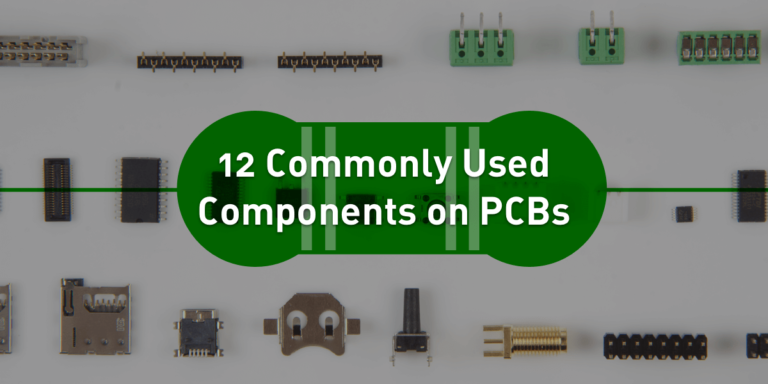
Components on PCB refer to electronic parts soldered on a printed circuit board (PCB). These components include resistors, capacitors, transactions, and integrated circuits, which form essential building blocks of electronic devices.
Embark on your journey into the exciting world of electronics. This guide will introduce you to the common ingredients used on PCBs for beginners. Discover the essential building blocks of resistors and circuits. They strengthen your devices.
Explore the basics of electronic circuits with our guide. It’s called ’12 Commonly Used Components on PCBs for Beginners.’ Learning about essential elements such as resistance cars, capacitors, and transistors, provides a basis for understanding how electronic devices work. Start your journey in electronics with this initial friendly review.
What is PCBs
Printed circuit boards, or PCBs, act as the backbone of electronic bias. Flat boards have a circuit that makes electricity inflow well. This allows the corridor to communicate well. No disturbances are when the factors communicate on these boards. The PCB plays an important part in furnishing a strong and systematised platform. To enhance colourful electronic factors from resistors to microprocessors.
Resistors
Resistors are important factors that are resistant. They limit the inflow of electrical current. They do this by deciding the quantum of resistance within a circuit. By arranging the inflow of electrons, resistors play a crucial part in managing the voltage position. And guarding sensitive constituents from inordinate spout.
Capacitors
Capacitors are small-bias. They save and release power energy. They act like temporary batteries. For beginners, an understanding of capacitors is important for electronics. These factors come in different types and sizes. The capacitors offer a protean tool for masterminds and potterers. This applies from the deciding power force to the time in the iconate.
Inductors
Individualities are important factors in electronic circuits. When an electric current passes through them, they store energy in the glamorous field. These simple yet important constituents play a crucial part in making power circuits work. They are available at HQ online and play a key role in making power circuits work. And introduce the principles that take into account different electronic bias.
Potentiometers
Potentiometers are simple but versatile electronic components well used in circuits. These acclimated resistors allow druggies to not by machine control the voltage in the circuit. These easy biases come in a variety of types, like rotary and slide Potentiometers.
They meet different operations. Potentiometers play an important part in furnishing customised and effective control over electronic systems. They have a straightforward design and are easy to integrate.
Transformers
These devices impart electrical energy between circuits through electromagnetic induction. A transformer consists of a primary coil, which receives input voltage. The secondary coil provides the changed output. This allows voltage regulation and distribution. These devices are often found in various devices. They help convert voltage and make energy use efficient.
Sensors
Sensors play an important role in collecting data and activating smart technology. These devices detect changes in the environment and turn them into electrical signals. They offer real-time information. From domestic climate temperature sensors to smartphones, these devices extend our daily lives. They provide quick and accurate feedback.
Diodes
Diodes are electronic constituents. They allow the present to flow in only one direction. They work as electrical faucets, allowing for smooth passage. They also help it in the contrary direction. Diodes play a crucial part in forming electrical overflows in electronic circuits. They’re important for newcomers. They’re one of the 12 Commonly Used Components On PCBs For Beginners.
Silicon-Controlled Rectifier (SCR)
The silicon-controlled therapy( SCR) is a semiconductor device. It plays an important part in electronic circuits. It acts as a controlled switch. When the power is actuated, it keeps supplying until the power goes below a certain position. It ensures a nonstop inflow of electricity until it drops to a specific point. This makes them mandatory in colourful electronic biases and systems.
Batteries
Batteries are movable power sources that secure and release energy for colourful bias. They come in different types, like alkaline, lithium-ion and rechargeable batteries. These compact biases play an important part in strengthening everything from everyday widgets. To electric vehicles, making them necessary in our ultramodern, moving life.
Integrated Circuits
Integrated circuits are small electronic biases. They pack a large number of constituents on the same chip. masterminds design these circuits to perform specific functions. These functions include parenting, signal processing, and data storehouse.
They play an important part in ultramodern electronics. This enables compact and effective bias, from smartphones to computers. Integrated circuits revise technology by adding effectiveness and minimizing size.
Oscillators
Oscillators called oscillators make signaling shapes, like signs or square swells, relatively frequently. They produce signals and play an important part in electronic circuits. frequency creators are important for effects like computer watches and radios.
They play a crucial part in making these biases work. masterminds use oscillators to make sure electronic systems are stable and accurate. These biases are essential for maintaining stability and perfection in colorful electronic systems.
Switches/Relays
Switch and relays to electronics are important biases. A switch is a simple element that opens or closes the circuit, controlling the inflow of power. But, relays, promoting and controlling power gestures, act as remote-control switches. They have a significant part in different operations.
Conclusion
In the world of electronics, our companion must be smooth. It covers 12 Commonly Used Components On PCBs For Beginners. Understanding the complications of these important factors can unleash the success of a structure. And understanding the original electronic bias. Start your hunt moment and empower yourself with introductory knowledge of PCB factors.